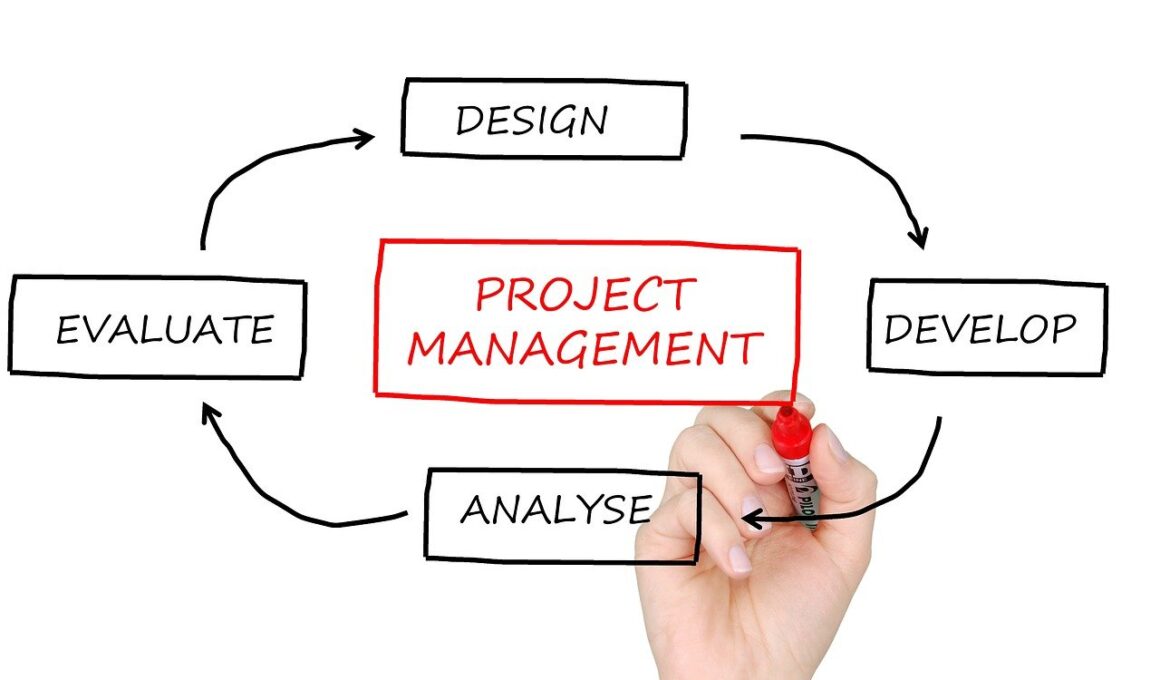Optimizing Project Selection Processes for Better Outcomes
In today’s fast-paced business environment, organizations must adopt efficient project selection processes to ensure successful outcomes. This involves evaluating numerous project proposals to identify initiatives that align closely with the organization’s strategic objectives. A systematic approach enables decision-makers to assess various factors, including potential risks, expected returns, and available resources. By implementing a structured evaluation matrix, teams can compare and prioritize projects based on quantitative and qualitative criteria. This method facilitates enhanced transparency and accountability, ultimately leading to more informed decision-making. Additionally, selecting the right projects helps to mitigate risks associated with resource allocation and project failure. Engaging stakeholders throughout the selection process fosters a collaborative environment and encourages diverse perspectives, which is critical for identifying the projects that hold the most promise for success. Moreover, using tools such as SWOT analysis and cost-benefit analysis enhances the accuracy of project evaluations. Continuous review and adaptation of selection criteria are vital, as organizations face new challenges and opportunities. By optimizing their project selection processes, organizations can improve overall outcomes and drive sustainable growth through well-chosen initiatives. Engaging with expert consultants may also bring valuable insights into improving selection practices.
Importance of Project Portfolio Management
Project Portfolio Management (PPM) plays an essential role in the overall success of organizations by providing a framework for managing multiple projects concurrently. By recognizing the interdependencies between projects, organizations can allocate resources more effectively and reduce the likelihood of bottlenecks and resource shortages. An optimized project portfolio allows managers to balance risk across a variety of projects, ensuring that some initiatives may offset the risks associated with others. Through proper PPM practices, organizations can prioritize high-impact projects that contribute significantly to their strategic objectives. This alignment of projects with the overall vision not only enhances the potential for tangible business results, but builds resilience in the face of shifting markets. Moreover, PPM enables organizations to maintain adaptability; they can pivot or discontinue projects that do not yield expected results, thereby maximizing the effective use of resources. Regular portfolio reviews allow organizations to remain responsive, ensuring relevant projects are continuously undertaken. Furthermore, utilizing software tools designed for PPM enhances data tracking and reporting capabilities, providing deeper insights for decision-making. Ultimately, embracing PPM fosters a culture of accountability and responsiveness that drives organizational growth.
Choosing the right criteria for selecting projects is a fundamental step in optimizing project selection processes. Organizations should define evaluation metrics that align closely with their strategic goals and objectives. Common selection criteria include project feasibility, alignment with business strategy, potential return on investment, and resource requirements. Engaging key stakeholders in this process can lead to a holistic understanding of what is critical for success. Additionally, incorporating adaptive criteria ensures that organizations can remain flexible and responsive to changing market trends. By establishing clear guidelines for assessing projects, decision-makers can improve overall efficiency in selecting the initiatives that will drive growth effectively. Ranking projects based on predetermined criteria enables transparency in decision-making, which builds trust among stakeholders. This systematic approach also facilitates the identification of projects that may require further exploration or development before a final decision is made. Revisiting and refining these criteria periodically allows organizations to stay in tune with both internal and external factors influencing project selection. A well-defined selection process not only streamlines the initial assessment but also sets the stage for successful project implementation and execution.
The role of data-driven decision-making cannot be overstated in optimizing project selection processes. By leveraging data analytics, organizations can gather valuable insights into historical project performance, market trends, and customer preferences. Data-driven approaches help identify patterns and correlations that might otherwise go unnoticed. This enables decision-makers to make informed choices based on empirical evidence rather than instinct. Integrating data analytics into the project selection framework enhances accuracy and enables organizations to prioritize projects that are likely to yield the highest returns. Moreover, predictive analytics can forecast potential outcomes, providing valuable foresight in evaluating project viability. Conducting regular data assessments allows organizations to refine their collection methods and improve decision-making agility over time. Establishing metrics for success, such as measuring project impact and customer satisfaction, supports ongoing evaluation and adaptation. Additionally, when organizations invest in identifying and implementing the right data tools, they benefit from greater efficiency during the decision-making process. Harnessing the power of data ultimately empowers organizations to cultivate a proactive culture, where continuous improvement becomes part of the mindset for project selection and execution.
Stakeholder Engagement in Project Selection
Engaging stakeholders throughout the project selection process is critical for optimizing outcomes and fostering collaboration. Stakeholders can include team members, management, clients, and even external partners. Their diverse perspectives contribute significantly to identifying potential opportunities and challenges that decision-makers may overlook. An inclusive approach not only improves the quality of project selection but also increases buy-in from participants, facilitating eventual project implementation. Effective communication strategies are essential to ensure stakeholders understand the criteria and processes involved in selecting projects. Regularly scheduled workshops and meetings allow for feedback and dialogue, creating a sense of ownership among all parties involved. Additionally, including stakeholders early in discussions allows organizations to address potential concerns, thus preventing conflicts later during project execution. Engaging with stakeholders can also uncover innovative ideas about new projects that align with strategic objectives. Furthermore, fostering a collaborative environment encourages creativity and knowledge sharing, which can significantly enhance project success rates. Prioritizing stakeholder engagement is therefore crucial for organizations aiming to improve their project selection processes and ensure better outcomes.
Applying the lessons learned from previous projects can lead to significant improvements in future project selection processes. Organizations should maintain thorough documentation and conduct retrospective analyses to assess which projects met their objectives and which fell short. Developing a knowledge repository helps preserve valuable insights gained from prior experiences, enabling teams to make more informed decisions during project selection. Moreover, identifying trends in successful projects can help organizations refine their selection criteria and methodologies. This feedback loop enhances the overall effectiveness of project selection practices by creating a culture of learning and continuous improvement. Additionally, sharing lessons learned among teams fosters cross-functional collaboration, which can lead to innovative solutions and better project outcomes moving forward. Cultivating an environment where organizations value reflection enhances their adaptability and responsiveness in project management. Encouraging an open dialogue regarding challenges faced in completed projects helps prevent the recurrence of common pitfalls. Consequently, organizations that prioritize learning from past experiences position themselves to optimize future project selection processes more effectively, thus increasing their chances of long-term success.
Future Trends in Project Portfolio Management
As organizations progress further into the digital era, several trends are emerging in the realm of Project Portfolio Management that could shape project selection processes. One significant trend is the increased use of artificial intelligence and machine learning to enhance data analysis capabilities. These technologies can automate the assessment of project proposals, helping organizations to expedite the selection process without compromising quality. Additionally, the focus on sustainability and corporate social responsibility (CSR) is prompting organizations to redefine project success metrics, incorporating environmental and social impacts into their evaluations. This shift necessitates a broader view of project selection, aligning with changing societal values and expectations. Agile methodologies are also gaining traction, offering organizations flexibility in project selection and execution, allowing them to respond to changing demands quickly. Lastly, the integration of remote collaboration tools fosters an inclusive and transparent decision-making process, enabling organizations to engage stakeholders more effectively. As these trends continue to evolve, organizations must adapt their project portfolio management practices to leverage opportunities for optimization, ensuring competitive advantages in ever-changing markets.
In conclusion, optimizing project selection processes is essential for organizations aiming to enhance outcomes and achieve strategic objectives. By employing structured methodologies, engaging stakeholders, leveraging data-driven decision-making, and learning from past experiences, organizations can improve their project portfolio management practices. The importance of aligning projects with organizational goals cannot be understated; it not only drives better results but also fosters resilience in dynamic business environments. With continuous evolution in project management practices, organizations must remain proactive in adapting to emergent trends, such as digital transformation and sustainability. Prioritizing collaboration, communication, and adaptability will empower businesses to navigate complexities in project selection and execution. Ultimately, those organizations that embrace these principles are likely to achieve success, thereby solidifying their competitive advantage in the market. As industries continue to change, successful project management will depend on a foundation of sound practices and an agile mindset. Organizations focused on optimizing their project selection processes are better positioned to make informed decisions that support long-term growth and innovation. By harnessing the insights provided throughout this article, organizations can take significant steps towards refining and enhancing their project management capabilities.


